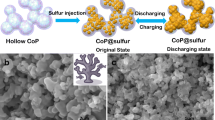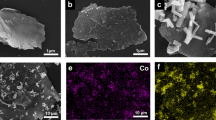Abstract
Controlling the inherent polysulfide shuttle process has been the key research topic to solve the irreversible capacity loss problem of Li–S battery. By skillfully designing, hierarchical brain coral-like WS2 nanosheets are synthesized. The novel structure is consisted of WS2 nanosheets arrayed along the same crystal plane, which expose a large number of adsorption active sites and enhance the adsorption of polysulfides. At the same time, the multilayer sheet structure has a large specific surface area and increases the sulfur loading. The brain coral-like WS2/S cathode exhibits excellent electrochemical properties, which delivers an initial discharge specific capacity of 1308 mAh g−1 at 0.1 C. And when cycles at 2 C, the discharge specific capacity is maintained at 721 mAh g−1 after 500 cycles, together with a low decay of 0.06% per cycle.







Similar content being viewed by others
References
Evers S, Nazar LF (2013) New approaches for high energy density lithium–sulfur battery cathodes. Acc Chem Res 46(9):1135–1143
Yin YX, Xin S, Guo YG, Wan LJ (2013) Lithium–sulfur batteries: electrochemistry, materials, and prospects. Angew Chem Int Ed Engl 52(50):13186
Yao YX, Zhang XQ, Li BQ et al (2020) A compact inorganic layer for robust anode protection in lithium–sulfur batteries. InfoMat 2(2):379–388
Chen L, Shaw LL (2014) Recent advances in lithium–sulfur batteries. J Power Sources 267:770–783
Chen W, Lei T, Wu C et al (2018) Designing safe electrolyte systems for a high-stability lithium–sulfur battery. Adv Energy Mater 8:1702348
Pang Q, Liang X, Kwok CY, Nazar LF (2015) The importance of chemical interactions between sulfur host materials and lithium polysulfides for advanced lithium–sulfur batteries. J Electrochem Soc 162(14):A2567–A2576
Nagao M, Imade Y, Narisawa H et al (2013) Reaction mechanism of all-solid-state lithium–sulfur battery with two-dimensional mesoporous carbon electrodes. J Power Sources 243:60–64
Ji X, Nazar LF (2010) Advances in Li–S batteries. J Mater Chem 20(44):9821
Lei T, Chen W, Hu Y et al (2018) A nonflammable and thermotolerant separator suppresses polysulfide dissolution for safe and long-cycle lithium–sulfur batteries. Adv Energy Mater 32:1802441
Mikhaylik YV, Akridge JR (2004) Polysulfide shuttle study in the Li/S battery system. J Electrochem Soc 151(11):A1969–A1976
Diao Y, Xie K, Xiong S, Hong X (2012) Analysis of polysulfide dissolved in electrolyte in discharge-charge process of Li–S battery. J Electrochem Soc 159(4):A421–A425
Zhang C, Wu HB, Yuan C, Guo Z, Lou XW (2012) Confining sulfur in double-shelled hollow carbon spheres for lithium–sulfur batteries. Angew Chem Int Ed 51(38):9592–9595
Chen W, Hu Y, Lv W et al (2019) Lithiophilic montmorillonite serves as lithium ion reservoir to facilitate uniform lithium deposition. Nat Commun 10:4973
Xin S, Gu L, Zhao NH et al (2012) Smaller sulfur molecules promise better lithium–sulfur batteries. J Am Chem Soc 134(45):18510–18513
Duan B, Wang W, Wang A et al (2013) Carbyne polysulfide as a novel cathode material for lithium/sulfur batteries. J Mater Chem A 1(42):13261
Xu K (2014) Electrolytes and interphases in Li-ion batteries and beyond. Chem Rev 114(23):11503–11618
Li Z, Yuan L, Yi Z et al (2014) Insight into the electrode mechanism in lithium–sulfur batteries with ordered microporous carbon confined sulfur as the cathode. Adv Energy Mater 4:1301473
Li BQ, Kong L, Zhao CX et al (2019) Expediting redox kinetics of sulfur species by atomic-scale electrocatalysts in lithium–sulfur batteries. InfoMat 1(4):533–541
Zhou H, Wang D, Fu A et al (2018) Mesoporous carbon spheres with tunable porosity prepared by a template-free method for advanced lithium–sulfur batteries. Mate Sci and Eng B 227:9–15
Sun X, Huang Y, Chen M, Wang Y, Gao X, Wang L (2018) Novel microporous carbon prepared from discarded clothes as host materials for high performance lithium–sulfur battery. Mater Lett 232:122–125
Ma S, Wang L, Wang Y et al (2019) Palladium nanocrystals-imbedded mesoporous hollow carbon spheres with enhanced electrochemical kinetics for high performance lithium sulfur batteries. Carbon 143:878–889
Liu J, Zhang W, Chen Y, Zhou P, Zhang K (2019) A novel biomimetic dandelion structure-inspired carbon nanotube coating with sulfur as a lithium–sulfur battery cathode. Nanotechnology 30(15):155401
Benítez A, Caballero A, Morales J, Hassoun J, Rodríguez-Castellón E, Canales-Vázquez J (2019) Physical activation of graphene: an effective, simple and clean procedure for obtaining microporous graphene for high-performance Li/S batteries. Nano Res 12(4):759–766
Zhao Q, Zhao K, Ji G et al (2019) High sulfur loading, rGO-linked and polymer binder-free cathodes based on rGO wrapped N, P-codoped mesoporous carbon as sulfur host for Li–S batteries. Chem Eng J 361:1043–1052
Cavallo C, Agostini M, Genders JP, Abdelhamid ME, Matic A (2019) A free-standing reduced graphene oxide aerogel as supporting electrode in a fluorine-free Li2S8 catholyte Li–S battery. J Power Sources 416:111–117
Kim J, Kang Y, Song S-W, Suk J (2019) Freestanding sulphur–graphene oxide/carbon composite paper as a stable cathode for high performance lithium–sulfur batteries. Electrochim Acta 299:27–33
Lei T, Chen W, Lv W et al (2018) Inhibiting polysulfide shuttling with a graphene composite separator for highly robust lithium–sulfur batteries. Joule 2:2091
Liu Q, Jiang Q, Jiang L et al (2018) Preparation of SnO2@rGO/CNTs/S composite and application for lithium–sulfur battery cathode material. App Surf Sci 462:393–398
Tu S, Zhao X, Cheng M, Sun P, He Y, Xu Y (2019) Uniform mesoporous MnO2 nanospheres as a surface chemical adsorption and physical confinement polysulfide mediator for lithium–sulfur batteries. ACS Appl Mater Interfaces 11(11):10624–10630
Cui Z, Yao J, Mei T et al (2019) Strong lithium polysulfides chemical trapping of TiC–TiO2/S composite for long-cycle lithium–sulfur batteries. Electrochim Acta 298:43–51
Zhu L, Yang C, Chen Y, Wang J, Wang C, Zhu X (2019) Lithium storage performance and mechanism of VS4/rGO as an electrode material associated with lithium–sulfur batteries. J Alloys Compd 785:855–861
Yuan Z, Peng HJ, Hou TZ et al (2016) Powering lithium–sulfur battery performance by propelling polysulfide redox at sulfiphilic hosts. Nano Lett 16(1):519–527
Li T, Guo R, Luo Y et al (2018) Innovative N-doped graphene-coated WS2 nanosheets on graphene hollow spheres anode with double-sided protective structure for Li-ion storage. Electrochim Acta 290:128–141
Xiao Z, Yang Z, Zhou L, Zhang L, Wang R (2017) Highly conductive porous transition metal dichalcogenides via water steam etching for high-performance lithium–sulfur batteries. ACS Appl Mater Interfaces 9(22):18845–18855
Majumder S, Shao M, Deng Y, Chen G (2019) Two dimensional WS2/C nanosheets as a polysulfides immobilizer for high performance lithium–sulfur batteries. J Electrochem Soc 166(3):A5386–A5396
Lei T, Chen W, Huang J et al (2017) Multi-functional layered WS2 nanosheets for enhancing the performance of lithium–sulfur batteries. Adv Energy Mater 7(4):1601843
Babu G, Masurkar N, Al Salem H, Arava LM (2017) Transition metal dichalcogenide atomic layers for lithium polysulfides electrocatalysis. J Am Chem Soc 139(1):171–178
Huang S, Wang Y, Hu J et al (2018) Mechanism investigation of high-performance Li-polysulfide batteries enabled by tungsten disulfide nanopetals. ACS Nano 12(9):9504–9512
Thangavel NK, Gopalakrishnan D, Arava LMR (2017) Understanding heterogeneous electrocatalysis of lithium polysulfide redox on Pt and WS2 surfaces. J Phys Chem C 121(23):12718–12725
Fu X, Qian J, Qiao X, Tan P, Peng Z (2014) Nonlinear saturable absorption of vertically stood WS2 nanoplates. Opt Lett 39(22):6450–6453
Sarma PV, Tiwary CS, Radhakrishnan S, Ajayan PM, Shaijumon MM (2018) Oxygen incorporated WS2 nanoclusters with superior electrocatalytic properties for hydrogen evolution reaction. Nanoscale 10(20):9516–9524
Liu S, Shen B, Niu Y, Xu M (2017) Fabrication of WS2-nanoflowers@rGO composite as an anode material for enhanced electrode performance in lithium-ion batteries. J Colloid Interface Sci 488:20–25
Qin Z, Ouyang C, Zhang J et al (2017) 2D WS2 nanosheets with TiO2 quantum dots decoration for high-performance ammonia gas sensing at room temperature. Sens Actuators B Chem 253:1034–1042
Feng C, Tang L, Deng Y et al (2020) Synthesis of branched WO3@W18O49 homojunction with enhanced interfacial charge separation and full-spectrum photocatalytic performance. Chem Eng J 389:124474
Patel MU, Demir-Cakan R, Morcrette M, Tarascon JM, Gaberscek M, Dominko R (2013) Li–S battery analyzed by UV/Vis in operando mode. ChemSusChem 6(7):1177–1181. https://doi.org/10.1002/cssc.201300142
Yao J, Mei T, Cui Z, Yu Z, Xu K, Wang X (2017) Hollow carbon spheres with TiO2 encapsulated sulfur and polysulfides for long-cycle lithium–sulfur batteries. Chem Eng J 330:644–650
Cui Z, Mei T, Yao J et al (2018) Cabbage-like nitrogen-doped graphene/sulfur composite for lithium–sulfur batteries with enhanced rate performance. J Alloys Compd 753:622–629
Acknowledgements
This work was financially supported by the Hubei Provincial Department of Science and Technology (Grant No. 2018CFB103), Ministry of Science and Technology of China (Grant No. 2016YFA0200200) and the National Natural Science Foundation of China (Grant No. 51673060, 11574075).
Author information
Authors and Affiliations
Corresponding authors
Ethics declarations
Conflict of interest
The authors declare that they have no conflict of interest.
Additional information
Publisher's Note
Springer Nature remains neutral with regard to jurisdictional claims in published maps and institutional affiliations.
Electronic supplementary material
Below is the link to the electronic supplementary material.
Rights and permissions
About this article
Cite this article
Xiong, M., Qian, J., Yang, K. et al. Efficient polysulfide anchor: brain coral-like WS2 nanosheets. J Mater Sci 55, 12031–12040 (2020). https://doi.org/10.1007/s10853-020-04760-x
Received:
Accepted:
Published:
Issue Date:
DOI: https://doi.org/10.1007/s10853-020-04760-x




